|
| Cobourg
- now and then |
|
|
|
|
|
|
| The
'Feel good' town
Appearing before Council, the consultant brought in to give the town a make-over says, 'Call Cobourg a 'feel good' town. This catchy phrase will work wonders for your tourist image.' She might have given a throaty little laugh, but if she did no one noticed. Having engaged the consultant, council was obliged to be impressed and readily agreed to support this exciting recommendation. His honour the mayor, a stickler for the protocol of Roberts Rules, seconded a motion of the most junior councillor (who barely scraped in at the last election) to designate Cobourg a 'feel good town'. When put to the vote, the motion passed unanimously as seven rubber stamps hit the deck with a single, resounding crash.
Given this authority, the town managers and directors of departments added another million to the budget in the twinkling of an eye and raised the mill rate a couple of points to cover the expense of new tourist brochures, pennants and the consultant's fees. In due course, the ritzy-looking pennants were hung from every lamp post in the centre of town area to spread the 'Welcome to our feel good town' news. It made the elderly and old timers in town want to gag, but what could they do? They were outnumbered. Yet immense was the rejoicing among the newcomers to town, who thought it would be great for the community's image. These were retirees mostly, civil servants and schoolteachers with their indexed pensions who arrived to buy the swanky harbour condos that they might end their days with a good view of the lake. In short, as numerous studies have shown, new catch phrases work wonders for neighborhoods suffering from low esteem. It wasn't always like that.
In the 19th Century heyday of its development, the settlement now known as Cobourg was originally called Amherst. It was renamed Cobourg in honour of the House of Saxe-Coburg-Gotha, which came to the British Royal Family in 1840 with the marriage of Queen Victoria of the House of Hanover to Prince Albert, son of Ernst of said Saxe-Coburg-Gotha. Incidentally, the only British monarch of Saxe-Coburg was King Edward VII, who visited the town in 1860 when he was HRH Prince of Wales. Unfortunately, the town council mistakenly added an 'o' to Coburg and probably blamed the chief for the error. In any case, Cobourg became the spelling, fixed forever after, and no one seemed the wiser.
This lively and industrious community on the north shore of Lake Ontario was once a bustling port of entry to Northumberland County and Peterborough. It once aspired to becoming the capital city of the Province, but this was not to be. Nevertheless, in its early days and before the advent of focus groups, out-sourced services and sub-contracted studies, the residents of Cobourg served and entertained themselves well. These notes are a tribute to the movers and shakers of the 20th Century who made the town bustle and vibrate with the vigour of their youth, for they were invincible - as indeed each new generation is - and confidently expected to live forever. By the turn of the Century, the social strata of the town was firmly established. At the lower end of the social scale, troublemakers, villains and scoundrels were hauled before the beak and given their just deserts. It didn't take a phalanx of police constables to maintain law and order. Without doing immense research, we can check progress in the field of law enforcement.
In 1964, for example, three police constables and a sergeant (like Yorrick, I knew him well) maintained order in a town with a population of 9,000. The inhabitants doubled to 18,000 by the turn of the 21st Century whereas the police department (today known as Police Services) had grown like Topsy to 32, but one digresses. We should begin with the harbour and its profusion of wild fowl that has established territorial ownership of the western side of the enclosed harbour for as long as living memory can recall. Its population of Canada geese numbering in the hundreds and mallard in the thousands have taken possession of a safe harbour and thrived on the abundance of food along the shore. Cormorants are seasonal along with the legions of seagulls that flocked in, for nature brought and abundance of capelin annually on to Cobourg beach. |
| Evidence of the profusion of wildfowl on this stretch of the Lake Ontario is found in the one-day bag of Frederick Field of Cobourg. Examination of the bag suggests the majority of Field's shoot were Mallard ducks and a couple of Canada geese. Such a shoot would be highly unlikely today. Frederick the 'sportsman' was course a man of standing, a member of one of Cobourg's prominent families about whom more may be written in due course. |
Frederick Field of Cobourg with
a day's bag of wild fowl thought to be taken in the 1920s |
|
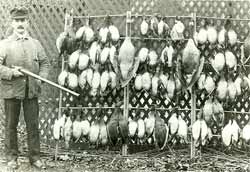 |
The easterly section of the harbour was equally busy. At the turn of the 20th Century, the core of Cobourg life, centred on its dockside and jetty. The main concrete dock and extension that ended with its lighthouse held a large warehouse and customs shed, the harbour master's office and other buildings essential to the commerce and lake traffic that helped sustain the town. The lighthouse marked the beginning of the harbour entrance, which was deep enough to take ocean-going vessels, sail or steam,. Until construction of the St. Lawrence Seaway in the 1950s, Cobourg catered only to vessels built for use on Lake Ontario. The lighthouse was equipped with a foghorn that sounded whenever fog and limited visibility descended on the lake. Given the brouhaha and dissension arising from the use of train whistles over the past twenty years, one might wonder what residents of the town would have made of the persistent and intermittent drone of the Cobourg fog horn. This audible warning to vessels was operational until well into the 1970s when the harbour entrance was narrowed by extension with rip-rap of the western breakwater. We know what the residents of the town thought about the foghorn because, like train whistles the length and breadth of Canada, it was a fact of life one came to accept. One wishes the same could be said for the annual waterfront festival, but that's a debatable matter.
Visitors coming to the harbour just to see what was going on were as common as a barber's chair; it was one heck of a busy place. Two huge ferries connected Cobourg with the booming City of Rochester, New York State, on the south shore of the Lake and, if visitors were lucky, there might even be two vessels in the harbour at the same time. The ferries were more than pleasure vessels, for they carried goods, merchandise and vehicles back and forth in a constant exchange of commerce. They also brought an annual influx of wealthy American families who owned large homes in and around Cobourg and shared in the life of the town for the season. They brought their own culture and, by all accounts, mixed exceptionally well with the natives, providing seasonal work for domestic servants, gardeners and artisans to keep their mansions in good repair. |
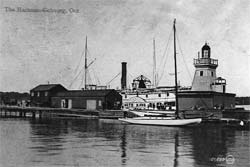 |
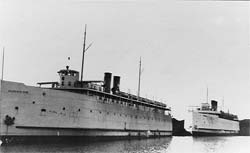 |
| A
view of the east quay of Cobourg harbour taken early in the 1900s.
Note the buildings and warehouses that stood on the quay. |
Ferries #1 and #2 serving Rochester, NY, Cobourg and other
Lake ports in the Cobourg harbour at the same time 23 October
1915. |
The harbour area had other activities going on beside those on the eastern quay. The centre pier at the water front had capacity to berth large lake vessels and was equipped with oil pipe lines to connect oil tankers for unloading fuel to the tank farm occupying land east of Hibernia Street and on which today the condominium complexes known as Victoria Gardens and Harbour Walk stand.
At the east corner of the harbour and south end of Division Street, a large coal shed stood with coal ready for transportation inland by rail. The railway spur line from the main CP and CN lines ran south in the centre of Spring Street, crossed King and veered off Hibernia, cutting south east at an angle to the harbour. Needless to say, trains had the right of way on Spring, and crossing King and on Hibernia Street. Until well into the 20th Century, horse-drawn wagons, traps and coaches wisely gave way to trains moving to and from the harbour.
Ferries that ploughed between Rochester, NY, Cobourg and other Lake Ontario ports carried on a thriving business transporting cargo, vehicles and passenger traffic. What with the passenger service, fuel oil, coal and industrial equipment moving in and out of Cobourg, the harbour was a place of constant activity. By the last quarter of the century, the harbour traffic and industry had diminished to a trickle. Ferries ceased serving the port, oil tankers and ocean-going vessels the served industry in town and the community came to an end. By the late 1970s the transformation of the harbour to accommodate small craft was complete.
|
King Street – hub of Cobourg Most residents of Cobourg know that milk comes from cows and that the 'farmers market' closes for the winter, which is the time for those living in the downtown area to venture farther afield for their fodder. Given the contemporary state of 'downtown Cobourg' with its bargain shops, its consignment and liquidation outlets; its life-style parlours pushing pills and potions for notions and ills; boutiques with nicks and knacks and crocheted toilet roll covers; wellness centres offering, rather one might think, suggestive 'glycolic feels'; pizza parlours with mottled bubble-gum pavements and coffee shops with curbside seating on carpets of cigarette butts, it would be difficult for visitors to imagine that King Street had ever been anything else but Ye olde and quaint made-over village shoppe centre with wooden sidewalks and a dirt carriageway.
You can tell how much downtown Cobourg has changed even from St Peter's Church at the east end of town where a massive $3 million expansion of church property at the time of writing is progressing with the speed of cathedral construction in medieval Europe. That once lovely structure now has an extension in a neo-Masonic temple style. To properly set it off it needs an all-seeing eye and compass chiseled in stone on the new portico. In contrast, Victoria Park opposite has changed, slightly for the better, though without much style. What once passed for a rose garden has replaced the hotel that once occupied the east corner of the park, but now lies ragged, neglected and forlorn. At the west corner there once stood the Chateau-by-the-Lake Hotel, which was demolished and replaced by an elaborately-designed park entrance that would merit an A for effort in any first year landscape architect's course; but one must not quibble.
In justice to - if not in praise of - the turn of the 20th Century, facing west, King Street was a far different place from what it is today. This main concourse of our 'feel good town' named King Street, stretching from Hoo Lee Gardens (a Chinese restaurant with uncommonly good fare, not a Chinese garden), at the north west corner of Victoria Park, to the Armouries a block west of Victoria Hall, was once a place of bustling activity. Butchers, bakers, greengrocers and drapers, hardware and grocery - or general provision - stores, banks and barber shops, tailors, men's and women's outfitters, shoe shops, newsagents, carriage-trade jewelers and insurance agents were crowded wall-to-wall in elegant late Victorian buildings in the shadow of town's famed Victoria Hall. Merchants and grocers supplied customers with entirely organic food; unlike today where packaged organic victuals are available at grossly inflated prices to those who can afford the exorbitant prices.
In common with all roads in the county, King Street had an unpaved carriageway suitable for horse-drawn vehicles, but little else. This is obvious in the photographs of the north side of King Street taken from the copula of Victoria Hall. On the other hand, pedestrians shopping the main thoroughfare were served with a convenience few other Ontario towns enjoyed. That is, the recently-installed concrete sidewalks paid for by the downtown merchants and grudgingly subsidized the town council were the pride of the town. Most every merchant and vendor provided a roll-down awning to protect shoppers from the summer sun as well as rain in inclement weather. The residents had every reason to believe that, like Pangloss in Candide, they lived in the best of all possible worlds |
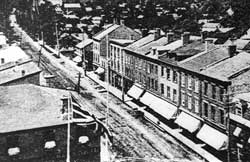 |
Views of King Street
taken from the copula of Victoria Hall: that on left
looking west, the opposite image a view looking east |
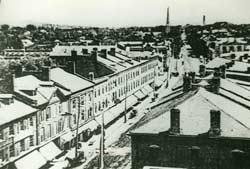 |
Victoria Hall is the magnificent and imposing main building, the centrepiece of Cobourg Town designed by architect and civil engineer Kivas Tully whose works with one exception are recognized in the Canadian Encyclopedia; that exception being Victoria Hall. This could be an oversight or it might have to do with every other community in the Province having its Victoria Hall in one shape or another. This being so, the CE editors might not in their learned judgment have considered Cobourg's gem worthy of mention. Homage to architect Tully is therefore dutifully paid as he, by all accounts, was duly paid for his architectural design. Edward Albert Prince of Wales opened Victoria Hall when he visited the town in 1860. He is reported to have '...danced the night away, to the obvious delight of Cobourg matrons.' It is all very well what history says about Cobourg's matrons, but given Prince Albert's reputation, the town fathers should have been concerned about Cobourg's daughters because, to this day, tradition has it that he dallied with more than one delightful maiden during his visit and bequeathed a legacy in the form - if not as his namesake - of a little Edward whose descendents yet surely carry the royal genes. |
|
 |
|
|
|
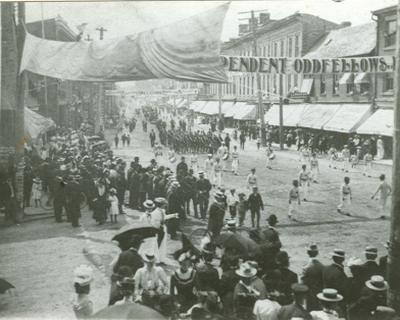 |
Victoria Day parade 1905 organised by the Independent Order of Oddfellows. Led by the Cobourg Citizens Band with a flanking escort of schoolchildren in colourful military costumes, the parade heads east on King Street past admiring onlookers lining the sidewalks. High above the parade a banner along with other festive hangings proclaims the Independent Oddfellows. |
In 1905, the Orange Order and the Grand Order of Independent Oddfellows occupied the top positions of influence in the community. The Order of Freemasons was a flourishing organisation too, but its activities were less overt than those of the Oddfellows and Orangemen. All these organisations - including Rebecca Lodges and church groups - did work in their own way to help the communities of which they were part. The main difference between the Orange Order and Independent Oddfellows was their affiliation. The Orange Order had strong military connections from its origins in Northern Ireland. The Oddfellows was more a fraternity of working class people as compared with the contemporary business community from which the Rotarians get their strength. The Independent Order of Foresters was another important fraternity active in the community.
Clarification of the service club movement is necessary to emphasize that, at the turn of the century, the Oddfellows held pride of place in the community. The philanthropic Oddfellows organised the annual Victoria Day parade, hung their banners across the King Street, marshaled the groups taking part, provided refreshments and advertised the occasion. By all accounts, the parade was always a grand occasion that entertained the locals and their U. S. visitors for the summer immensely.
|
|
 |
|
The circus comes to town headed by a horse-drawn wagon crossing the intersection of King and Division streets with the Dominion Bank in the background, space today occupied by Kawartha Credit Union. With so much horse-drawn transport in town, one wonders what arrangements the town council had for removing horse droppings from the unpaved carriageway of King and Division. |
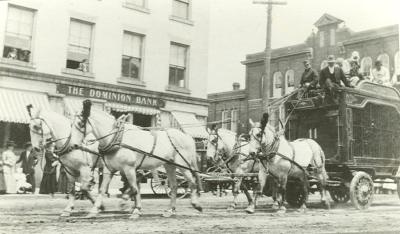 |
| No description
of King Street at the turn of the Century would be complete without
some mention of entertainment for the town's residents from visiting
circuses and fairs. Cobourg was a on a regular circus route that paraded
along King Street with musicians atop the wagons to announce their
arrival. The circus provided a big-top spectacle of 'wild animals'
under a ringmaster, acrobatic performers, scantily-clad women riding
the same horses in the tent that drew the wagons through town and,
of course, every circus had an over abundance of clowns and therefore
more than enough to do around. |
 |
|
|
Occasional social activities in the early 19th Century |
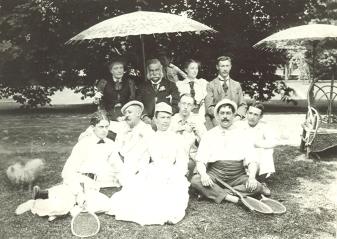 |
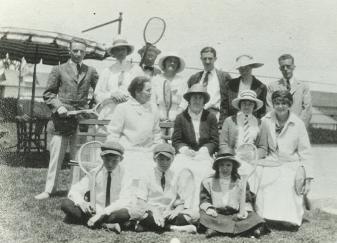 |
| Tennis party (c 1912) Back: Mike Albertini, John Daintny, Rebecca Cornell, (?) Daintny, front: Piquette Mitchell, Colonel Cornell, Mrs Haskell, Sam Cornell, Singnor Altertini, Doty. |
Tennis party at Cottesmore Hall (c1920) The names of the people in this group are
unknown.
|
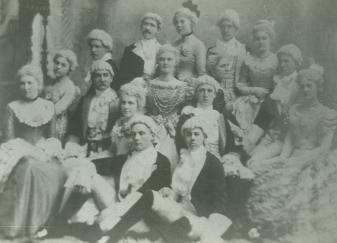 |
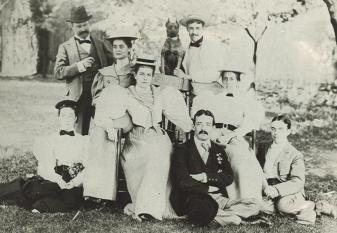 |
| Costume party thought to have been held in Victoria Hall, (year unknown). The only person identified in this photograph is Gertrude Tate on the extreme right of the third row. |
Garden party of unknown provenance. Garden party; seated on ground - , -, Lawrence Fowler seated on chairs Mary C. Bass, Nashville Jenn |
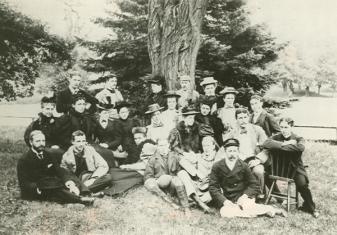 |
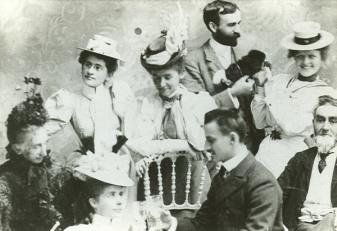 |
| Front, Mr. Watson (Utica, NY), Dick Merrick, (Howard Cty, Maryland), Miss MaDonald (NY), - , Donald Armour, Capt. Miles Back: Adolph Bennet (Chile), Nellie Swan, Douglas Cornell Jnr, - , Mary Bass (Nashville), Lawrence Fowler, Miss Charlotte Campear, Ethel Guebery, Miss Watson (Utica), Miss Poundoin, (Baltimore), Jennet Lee, (St. Louis) Elsie Armour, Cora Carrington, Louise Mitchell, Lawrence A. Fowle (c1910). |
Family gathering of the Kerrs: Front - Edith Kerr, French Canadian; second row - Myra Field Ken, William Kerr; third row - Mebel Kerr, Lenah Kerr. |
 |
 |
|
The Municipal Council
From age to age various combinations of mayors, deputy mayors and councillors have directed the administrative operations of the municipality, set the annual budget and managed the affairs of the community. Some councils have been more effective, more prudent and fiscally responsible than others. Councillors have set the salaries of the town managers and decided what level of honoraria they would themselves receive for their services to the community.
For their efforts, those serving on council have been criticized, chastised, rebuked and castigated for their decisions to burden the citizens with an ever-increasing indebtedness. [At the time of writing, Cobourg has the highest municipal taxes in the Province of Ontario.] Yet, bold as critics may be in rebuking councillors for their performance - or perceived lack of performance in representing the electorate - it is rare that those who vociferate would contest a seat on council when the next election time comes round. In short, those who would seek election are few and, it seems, this has ever been the case throughout the 20th Century. Of one incumbent mayor it was said that the town clock had twice as many faces as he. One most agreeable and complacent face he had for those who declined to question his authority, his wishes or for that matter challenged his certitude, for in all things he had the conviction of a principal who brooks no opposition to his governance. His second face he reserved for those with impudence to question his authority; to these he gave short shrift: eyes glazed over with indifference and lips drawn tight for close-hauled sailing on a windy lake.
Such is the unkind and heartless opinion served on those who function in public office, which is a hazard all municipal councilors risk. It is with regard to the difficulty of finding civic-minded citizens willing seek election to municipal office that the image reproduced here refers.
|
| |
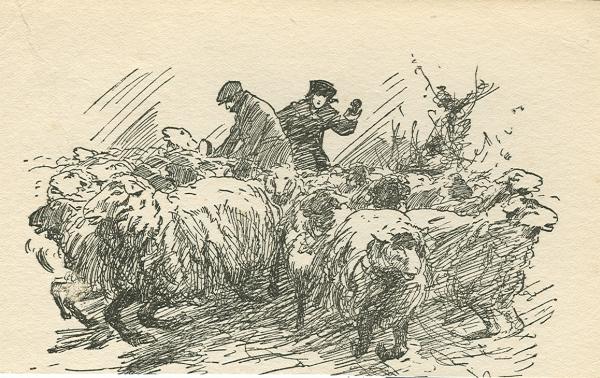 |
|
| |
Selection committee in search of candidates for council |
|
| Found in a box of memorabilia presumed to have once belonged to Mr Skitch, a photographer of Cobourg (c 1880 - 1967), was this postcard bearing an artist's illustration and a penciled note on the reverse reading, 'Selection Committee in search of candidates for election to council.' Interestingly, in the 1920s at least, the community experienced difficulty in attracting candidates to serve on the municipal council. |
 |
|
 |
|
|
|
|
|
|
 |
 |
 |
 |
 |

